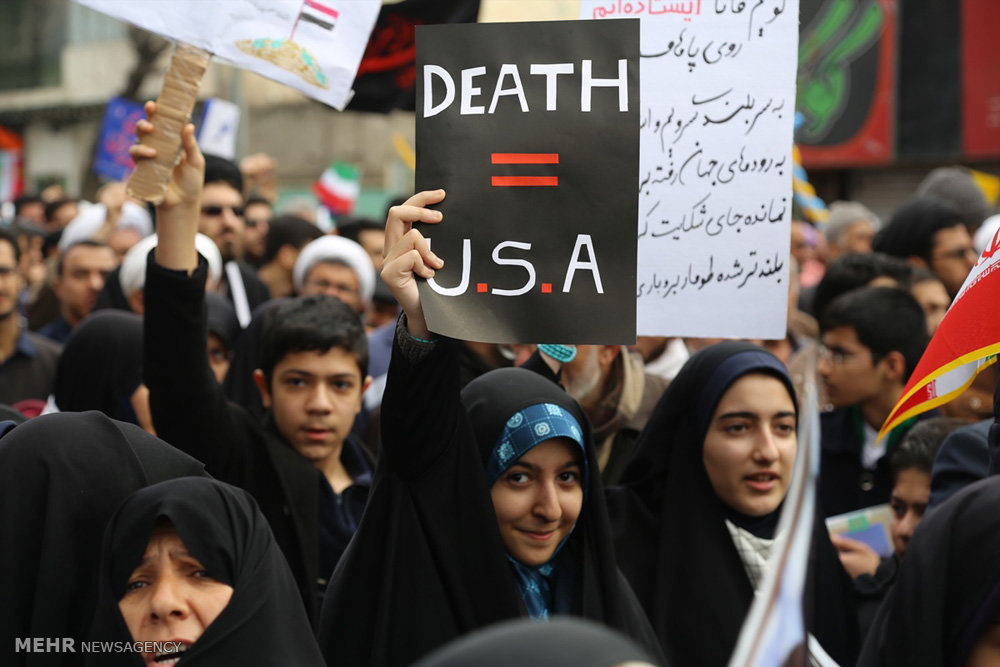Today it’s “Neither East, nor West – but the Islamic Republic”

Exactly 38 years ago, Ayatollah Ruhollah Khomeini returned to Iran after 15 years in exile. February 10 was the last day of the “ten days of dawn” that celebrate his return and commemorate the victory of the Iranian Revolution.
The Islamic Revolution rejected the tyranny of both Western and Eastern powers, heralding the “Neither East, nor West – but the Islamic Republic!”
Even at 8 a.m. Ferdowsi Square is crowded, full of people, rows of artists dressed in white are painting portraits of veterans of the revolution and the Iran-Iraq war.
The Iranian flag is omnipresent on shoulders of people, its silky material waving in the wind against the backdrop of a cloudy sky. Persian music fills the air through loud speakers; the atmosphere of the morning is slowly building up to revolutionary heights of this day’s historical commemoration.
“I Am a Revolutionary”, says a sign in hands of the elderly pushed in wheelchairs, most of whom were there when the Shah’s reign came to an end. Most of whom were the mobilizing force that helped overthrow his rule over Iran after decades of oppression and corruption.
“When the Shah left the country, I was very happy. I participate in the rally every year for the same reason I was motivated by 38 years ago,” says Gholamreza, a 60-year-old man with a white beard wearing an old-fashioned black hat. Recalling the events of 1979, he adds: “I was one of those revolutionary guys at that time and was jailed four to five days by security forces. I was the one who pulled down the statue of the Shah. We even torched minibuses!”
Not only weathered revolutionaries march through the streets of Tehran on this day, also upcoming generations take to the streets to express their support for the revolution. Young men and women are vigorously marching, holding signs saying “Down with U.S.A.” or “Down with Israel”, these very same words echoing in a young man’s voice all through Tehran like a mantra.
A group of young female students draped in chadors are energetically chanting slogans: “Down with U.S.A., Down with Israel, Down with England, Down with Hypocrites”. Their high voices barely audible in the massive crowd. “I will sacrifice my life for safeguarding my country,” they shout in unison.
The leader of the group, the 14-year-old Maedeh Teymouri, says she is here to prove that “America cannot do a damn thing” against Iran.
However, it does not do to dwell on the idea that Iranians, who took to the streets to celebrate the 38th anniversary of the Islamic Revolution, maintain a hateful attitude towards the U.S.
On the contrary, countless signs emerge on the streets, thanking the American people for their support and solidarity: “Long Live U.S. People” reads one sign and “American people are welcome and invited to visit Iran,” reads another held by a peculiar elderly man. On its other side, the sign shows a caricature of U.S. President Trump beheading the Statue of Liberty. “Goodbye to American Values,” it reads.
Hossein, 35, was born after the revolution, yet has reasons to participate in the rallies. He is grateful that Islam prevailed and feels that such rallies are like a referendum and those who participate utter their support for the Islamic Republic.
According to him, the rallies help present a strong popular image of the revolution and shore up Iran’s national security.
Chants all across the packed Azadi Street from various participants proclaim that “God is great” and that “Iranians are not scared of threats”.
The overwhelming sentiment of national pride and hope for the future intensifies as the crowd moves closer and closer to Azadi Square. President Rouhani’s voice reverberates through countless speakers installed on the streets, roaring above the huge passionate crowd.
Television reporters, photographers, journalists are everywhere, trying to capture memorable moments, trying to translate the massive demonstration into a perceptible, comprehensible happening.
It seems like this could easily be 1979 when people came to the streets because they didn’t lose hope, because they had a cause, a purpose to fight and stand up for. However, it’s 2017 now and despite several setbacks in the form of sanctions, the nation “will always keep standing up”, as one of the many signs reads. The resilience, the strong spirit and pride of the Iranian nation shines through the crowd like a beacon of hope.
“When the revolution happened I was 12, exuberant and energetic,” says the 50-year-old Mehdi, who was paralyzed during Iraq’s war against Iran in the 1980s and is now wheelchair-bound.
“Today’s participation shows that people do believe and continue to believe in what was done 38 years ago. These days are reminiscent of those revolutionary days. With every passing day it’s getting better politically, economically and on the level of defense.”
AK/PA
